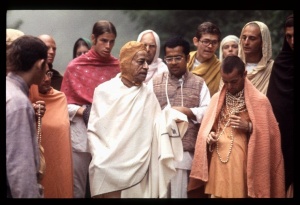SB 9.18.5: Difference between revisions
m (1 revision(s)) |
(Vanibot #0054 edit - transform synonyms into clickable links, which search similar occurrences) |
||
| (One intermediate revision by one other user not shown) | |||
| Line 1: | Line 1: | ||
{{info | {{info | ||
|speaker= | |speaker=King Parīkṣit | ||
|listener= | |listener=Śukadeva Gosvāmī | ||
}} | }} | ||
[[Category:Srimad-Bhagavatam - Canto 09 Chapter 18|s05 ]] | |||
[[Category:Bhagavatam Verses Spoken by Pariksit Maharaja - Vanisource|091805]] | |||
<div style="float:left">'''[[Srimad-Bhagavatam]] - [[SB 9|Ninth Canto]] - [[SB 9.18: King Yayati Regains His Youth|Chapter 18: King Yayāti Regains His Youth]]'''</div> | |||
<div style="float:right">[[File:Go-previous.png|link=SB 9.18.4]] '''[[SB 9.18.4]] - [[SB 9.18.6-7]]''' [[File:Go-next.png|link=SB 9.18.6]]</div> | |||
{{RandomImage}} | |||
==== TEXT 5 ==== | ==== TEXT 5 ==== | ||
<div | <div class="verse"> | ||
śrī-rājovāca | :śrī-rājovāca | ||
brahmarṣir bhagavān kāvyaḥ | :brahmarṣir bhagavān kāvyaḥ | ||
kṣatra-bandhuś ca nāhuṣaḥ | :kṣatra-bandhuś ca nāhuṣaḥ | ||
rājanya-viprayoḥ kasmād | :rājanya-viprayoḥ kasmād | ||
vivāhaḥ pratilomakaḥ | :vivāhaḥ pratilomakaḥ | ||
</div> | </div> | ||
| Line 18: | Line 23: | ||
==== SYNONYMS ==== | ==== SYNONYMS ==== | ||
<div | <div class="synonyms"> | ||
śrī-rājā | ''[//vanipedia.org/wiki/Special:VaniSearch?s=śrī&tab=syno_o&ds=1 śrī]-[//vanipedia.org/wiki/Special:VaniSearch?s=rājā&tab=syno_o&ds=1 rājā] [//vanipedia.org/wiki/Special:VaniSearch?s=uvāca&tab=syno_o&ds=1 uvāca]'' — Mahārāja Parīkṣit inquired; ''[//vanipedia.org/wiki/Special:VaniSearch?s=brahma&tab=syno_o&ds=1 brahma]-[//vanipedia.org/wiki/Special:VaniSearch?s=ṛṣiḥ&tab=syno_o&ds=1 ṛṣiḥ]'' — the best of the ''brāhmaṇas''; ''[//vanipedia.org/wiki/Special:VaniSearch?s=bhagavān&tab=syno_o&ds=1 bhagavān]'' — very powerful; ''[//vanipedia.org/wiki/Special:VaniSearch?s=kāvyaḥ&tab=syno_o&ds=1 kāvyaḥ]'' — Śukrācārya; ''[//vanipedia.org/wiki/Special:VaniSearch?s=kṣatra&tab=syno_o&ds=1 kṣatra]-[//vanipedia.org/wiki/Special:VaniSearch?s=bandhuḥ&tab=syno_o&ds=1 bandhuḥ]'' — belonged to the ''kṣatriya'' class; ''[//vanipedia.org/wiki/Special:VaniSearch?s=ca&tab=syno_o&ds=1 ca]'' — also; ''[//vanipedia.org/wiki/Special:VaniSearch?s=nāhuṣaḥ&tab=syno_o&ds=1 nāhuṣaḥ]'' — King Yayāti; ''[//vanipedia.org/wiki/Special:VaniSearch?s=rājanya&tab=syno_o&ds=1 rājanya]-[//vanipedia.org/wiki/Special:VaniSearch?s=viprayoḥ&tab=syno_o&ds=1 viprayoḥ]'' — of a ''brāhmaṇa'' and a ''kṣatriya''; ''[//vanipedia.org/wiki/Special:VaniSearch?s=kasmāt&tab=syno_o&ds=1 kasmāt]'' — how; ''[//vanipedia.org/wiki/Special:VaniSearch?s=vivāhaḥ&tab=syno_o&ds=1 vivāhaḥ]'' — a marital relationship; ''[//vanipedia.org/wiki/Special:VaniSearch?s=pratilomakaḥ&tab=syno_o&ds=1 pratilomakaḥ]'' — against the customary regulative principles. | ||
</div> | </div> | ||
| Line 25: | Line 30: | ||
==== TRANSLATION ==== | ==== TRANSLATION ==== | ||
<div | <div class="translation"> | ||
Mahārāja Parīkṣit said: Śukrācārya was a very powerful brāhmaṇa, and Mahārāja Yayāti was a kṣatriya. Therefore I am curious to know how there occurred this pratiloma marriage between a kṣatriya and a brāhmaṇa. | Mahārāja Parīkṣit said: Śukrācārya was a very powerful brāhmaṇa, and Mahārāja Yayāti was a kṣatriya. Therefore I am curious to know how there occurred this pratiloma marriage between a kṣatriya and a brāhmaṇa. | ||
</div> | </div> | ||
| Line 32: | Line 37: | ||
==== PURPORT ==== | ==== PURPORT ==== | ||
<div | <div class="purport"> | ||
According to the Vedic system, marriages between kṣatriyas and kṣatriyas or between brāhmaṇas and brāhmaṇas are the general custom. If marriages sometimes take place between different classes, these marriages are of two types, namely anuloma and pratiloma. Anuloma, marriage between a brāhmaṇa and the daughter of a kṣatriya, is permissible, but pratiloma, marriage between a kṣatriya and the daughter of a brāhmaṇa, is not generally allowed. Therefore Mahārāja Parīkṣit was curious about how Śukrācārya, a powerful brāhmaṇa, could accept the principle of pratiloma. Mahārāja Parīkṣit was eager to know the cause for this uncommon marriage. | According to the Vedic system, marriages between ''kṣatriyas'' and ''kṣatriyas'' or between ''brāhmaṇas'' and ''brāhmaṇas'' are the general custom. If marriages sometimes take place between different classes, these marriages are of two types, namely ''anuloma'' and ''pratiloma. Anuloma'', marriage between a ''brāhmaṇa'' and the daughter of a ''kṣatriya'', is permissible, but ''pratiloma'', marriage between a ''kṣatriya'' and the daughter of a ''brāhmaṇa'', is not generally allowed. Therefore Mahārāja Parīkṣit was curious about how Śukrācārya, a powerful ''brāhmaṇa'', could accept the principle of ''pratiloma''. Mahārāja Parīkṣit was eager to know the cause for this uncommon marriage. | ||
</div> | </div> | ||
__NOTOC__ | |||
<div style="float:right; clear:both;">[[File:Go-previous.png|link=SB 9.18.4]] '''[[SB 9.18.4]] - [[SB 9.18.6-7]]''' [[File:Go-next.png|link=SB 9.18.6]]</div> | |||
__NOTOC__ | |||
__NOEDITSECTION__ | |||
Latest revision as of 23:48, 18 February 2024

A.C. Bhaktivedanta Swami Prabhupada
TEXT 5
- śrī-rājovāca
- brahmarṣir bhagavān kāvyaḥ
- kṣatra-bandhuś ca nāhuṣaḥ
- rājanya-viprayoḥ kasmād
- vivāhaḥ pratilomakaḥ
SYNONYMS
śrī-rājā uvāca — Mahārāja Parīkṣit inquired; brahma-ṛṣiḥ — the best of the brāhmaṇas; bhagavān — very powerful; kāvyaḥ — Śukrācārya; kṣatra-bandhuḥ — belonged to the kṣatriya class; ca — also; nāhuṣaḥ — King Yayāti; rājanya-viprayoḥ — of a brāhmaṇa and a kṣatriya; kasmāt — how; vivāhaḥ — a marital relationship; pratilomakaḥ — against the customary regulative principles.
TRANSLATION
Mahārāja Parīkṣit said: Śukrācārya was a very powerful brāhmaṇa, and Mahārāja Yayāti was a kṣatriya. Therefore I am curious to know how there occurred this pratiloma marriage between a kṣatriya and a brāhmaṇa.
PURPORT
According to the Vedic system, marriages between kṣatriyas and kṣatriyas or between brāhmaṇas and brāhmaṇas are the general custom. If marriages sometimes take place between different classes, these marriages are of two types, namely anuloma and pratiloma. Anuloma, marriage between a brāhmaṇa and the daughter of a kṣatriya, is permissible, but pratiloma, marriage between a kṣatriya and the daughter of a brāhmaṇa, is not generally allowed. Therefore Mahārāja Parīkṣit was curious about how Śukrācārya, a powerful brāhmaṇa, could accept the principle of pratiloma. Mahārāja Parīkṣit was eager to know the cause for this uncommon marriage.